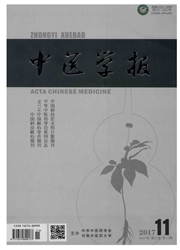

 中文摘要:
中文摘要:
目的:通过对2型糖尿病气阴两虚证患者血清进行代谢组学检测,观察早期胰岛素强化治疗前后血清代谢产物的变化及与健康组代谢产物的差别。方法:将纳入研究的2型糖尿病气阴两虚证患者20例采用胰岛素强化治疗,同时采用气相色谱-质谱联用方法进行治疗前后代谢组学检测,应用主成分分析法和偏最小二乘判别分析法进行分析。结果:治疗前后血浆代谢产物鉴定,并与健康组比较,其潜在生物标志物主要有溶血磷脂酸、磷脂酰乙醇胺、神经节苷脂、卵磷脂、二酰甘油、心磷脂、三酰甘油、溶血磷脂、磷脂酰肌醇磷酸、胆甾烯基癸酸酯、二氢生物蝶呤、脲基琥珀酸,并且经生物标志物含量测定及对比,差异有统计学意义(P〈0.05)。结论:2型糖尿病气阴两虚证有特异的代谢标记物,与健康对照组比较存在内源性代谢产物差异。
 英文摘要:
英文摘要:
Objective: Through detection serum metabolomics Qi and Yin deficiency Syndrome patients of type 2 diabetes,Observe changes in serum metabolites and differences with healthy group of metabolites before and after early intensive insulin therapy. Methods: The Qi and Yin deficiency in patients with type 2 diabetes will be included in the study 20 cases using intensive insulin therapy,using gas chromatography-mass spectrometry methods for treatment after metabolomics testing conducted,using principal component analysis and partial least squares discriminant analysis analysis. Results: Before and after treatment,the plasma metabolite identification,and compared with the healthy group,its main potential biomarkers lysophosphatidic acid,phosphatidylethanolamine,gangliosides,phosphatidylcholine,diglycerides,cardiolipin,triglycerides,lysophosphatidy lethanolamine,phosphatidylinositol phosphate,cholesteryl decanoate,dihydrobiopterin,Ureidosuccinic acid,and by the biological matter content and contrast logo,P 0. 05,the difference was statistically significant. Conclusion: Qi and Yin deficiency type 2 diabetes have specific metabolic markers and have different endogenous metabolites compared with healthy controls.
 同期刊论文项目
同期刊论文项目
 同项目期刊论文
同项目期刊论文
 期刊信息
期刊信息
